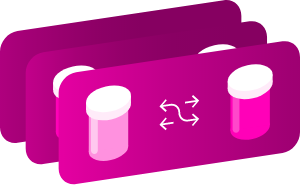quinagolide的影响和卡麦角林,两个选择性多巴胺受体2型受体激动剂,治疗泌乳素瘤。
文章的细节
-
引用
复制到剪贴板 -
Di Sarno,蓝迪毫升,马尔祖洛P, Di外轮山C, Pivonello R, Cerbone G, Lombardi G,科劳
quinagolide的影响和卡麦角林,两个选择性多巴胺受体2型受体激动剂,治疗泌乳素瘤。
中国性(Oxf)。2000年7月,53 (1):53-60。
- PubMed ID
-
10931080 (在PubMed]
- 文摘
-
目的:比较的疗效和耐受性quinagolide (CV 205 - 502)和卡麦角林(出租车)治疗泌乳素瘤患者39。研究设计:所有39患者治疗的第一个quinagolide为12个月,然后卡麦角林为12个月。一段本事进行12个月的治疗后所有患者为了评估hyperprolactinaemia复发。病人:23 microprolactinoma患者(基底血清PRL水平1620 - 18750亩/ l)患者和16 macroprolactinoma(基底血清PRL水平4110 - 111000亩/ l),之前是不能容忍溴麦角环肽。所有患者性腺的失败和患者11 macroprolactinoma视野都有缺陷。五个宏观和一个患者microprolactinoma曾做过手术。研究协议:quinagolide与驾驶室的起始剂量为0.075毫克/天,0.5毫克/周,分别随后增加了0.6毫克,每日一次,每周两次,1.5毫克。血清PRL水平测量每月前3个月,然后每季度为12个月。PRL水平为第一个月每周化验,然后每月冲洗期间。肿瘤收缩是由串行评估磁共振成像(MRI)的研究hypothalamus-pituitary地区研究入口和在微观6和12个月的治疗后,macroprolactinomas。 RESULTS: After 12 months of quinagolide treatment, serum PRL levels normalized in all 23 patients with microprolactinoma (100%) and in 14 out of 16 with macroprolactinoma (87.5%). A tumour volume reduction of greater than 80% was documented by MRI studies in five of 23 (21.7%) patients with microprolactinoma and in four of 16 (25%) with macroprolactinoma. All patients had recurrence of hyperprolactinaemia after 15-60 days withdrawal of quinagolide treatment. However, before starting CAB treatment basal PRL levels were significantly lower than before quinagolide treatment both in microprolactinomas (4667.4 +/- 714.7 vs. 2636.1 +/- 262.3 mU/l, P = 0.006) and in macroprolactinomas (24853.1 +/- 7566.7 vs. 3576.6 +/- 413.0 mU/l, P = 0.013). After 12 months of CAB treatment, serum PRL levels normalized in 22 out of 23 patients with microprolactinoma (95.6%) and in 14 out of 16 with macroprolactinoma (87.5%). No difference in PRL nadir was found after quinagolide and CAB treatments both in micro 174.6 +/- 30.6 vs. 169.8 +/- 37.9 mU/l, P = 0.5) and in macroprolactinomas (277.5 +/- 68.4 vs. 341.8 +/- 95.2 mU/l, P = 0.6). A tumour volume reduction of greater than 80% was documented by MRI studies in seven other patients with microprolactinoma (30.4%) and in five other patients with macroprolactinoma (31.2%). After CAB treatment, further tumour shrinkage ranging 4-40% and 2-70% was observed in 12 micro- and seven macroprolactinomas, respectively. The percentage of tumour shrinkage after CAB was significantly higher than that observed after quinagolide in microprolactinomas (48.6 +/- 9.5 vs. 26.7 +/- 4. 5%, P = 0.046) but not in macroprolactinomas (47.0 +/- 10.6 vs. 26.8 +/- 8.4%, P = 0.2). The withdrawal from CAB treatment, induced an increase in serum PRL levels in all macroprolactinomas between 15 and 30 days, in 15 out of 23 microprolactinoma after 30 days, and in four patients after 2-4 months. In the remaining four patients serum PRL levels remained normal after 12 months of CAB withdrawal. Both compounds were tolerated satisfactorily by all patients. In the first week of quinagolide treatment, 12 patients reported nausea and postural hypotension, which spontaneously disappeared during the second-third week of treatment. None of the 39 patients reported side-effects during CAB treatment. CONCLUSIONS: Both quinagolide and CAB treatments, induced the normalization of serum PRL levels in the great majority of patients with prolactinoma. Tumour shrinkage was recorded in 22-25% of patients after quinagolide and in 30-31% after CAB treatment
DrugBank数据引用了这篇文章
- 药物
- 药物的相互作用Learn More" title="" id="structured-interactions-info" class="drug-info-popup" href="javascript:void(0);">
-
药物 交互 整合药物之间
在您的软件的交互
